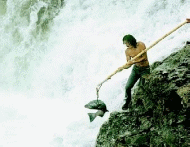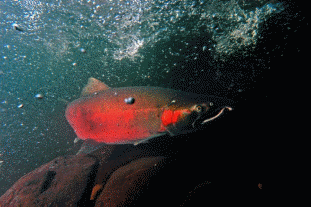Abstract
Columbia River plays significant role in the lives of the aboriginal communities in Canada. It is a source of water, fish especially salmon and other resources. This paper discusses the current aboriginal involvement with the Columbia River, the current celebrations associated to it and salmon as well as the impacts of human activities on salmon.
Introduction
The land and waters of River Columbia Basin provide rich natural resources, mainly, salmon and cedar, to the aboriginal communities in this region. The aboriginal communities on the Canadian side of the river have highly structured cultures which are very similar since they share certain characteristics like the significance of salmon to their cultures.
Some of the aboriginal tribes who live around and utilize the Columbia River resources include the Metis people in the Kootenay Region, the Sinixt people in the Upper Columbia Basin, the Skoyelpi (Colville) who are neighbours to the Sinixt people, Ktunaxa, Shuswap, Kalispel, Oreille and Flathead among others.
Current Aboriginal involvement with the Columbia River
Salmon has economic importance for these tribes since it has been and is still used for trade and as food. Salmon had spiritual as well as cultural significance in some cultures especially the Indian Colvilles, and they would perform rituals to celebrate salmon harvest.
Today, salmon remains the richest as well as the most important wild food source for the aboriginal communities that live in the Columbia Basin. Thus, they have continually exploited Columbia River to harvest their important wild food, salmon.
The aboriginal communities also use Columbia River for logging timber that they transport to the saw mills established in the region to exploit the temperate forests in the basin. They also use the river for recreation purposes.
The aboriginal communities of Canada have also recognized the economic importance of Columbia River have increased their involvement in the conservation of the river and its natural resources which include Salmon fish. The aboriginal tribes, states and the federal government are partnering to restore as well as to improve the water and land quality of the Columbia River Basin (Quinn, 1991).
Current celebrations of the River and its salmon
For hundred of years, the aboriginal communities of Canada living in River Columbia Basin have had elaborate rituals as well as ceremonies as they celebrate the return of salmon into the river.
Many aboriginal tribes in Canada still celebrate the first harvest of Chinook salmon every year since chinook is the most common salmon that spawn in the river (Montgomery, 2003). These people are largely fishermen and therefore always anticipate the return of salmon, especially steelhead, chinook, and sturgeon salmon which are the most favoured for sport fish due to their strength as well as fighting spirit.

Lang (n.d) states that sport fishing for salmon particularly steelhead began in the Columbia River in the 1920s and has since developed and expanded a great deal. Today, people have increasingly used power boats for sport fishing. Other forms of sport which have developed in the river include water skiing, sailing, swimming, canoeing, as well as, day cruising among other water sports (Lang, n.d).
Human effects on the salmon run
Several human activities affect salmon run in the river. Lang (n.d) reports that construction of dams on the river has contributed significantly to the serious decline in salmon runs. The dams have led to a decline of salmon habitats due to the changing river conditions.
Lang (n.d) states that commercial fishing increased in 1860-1960s harvesting millions of pounds salmon fish. The natives have continually used seines and gillnets at the estuary as well as lower river for fishing. In the middle river, they have mostly used setnets, dipnets in addition to hooks.
Below is a picture of a native fisherman fishing along Columbia River.

In response to this, several non-governmental organizations have begun to collaborate with the aboriginal communities and government agencies to establish fish hatcheries to help save salmon from depletion.
Salmon returning to their spawning areas are caught, their eggs removed and taken to the hatcheries to be hatched and then placed in nurseries where they are allowed to grow to maturity. Thereafter, they are released into the river. This helps conserve and maintain salmon population in the river.
Below is a picture showing a coho salmon making its way to Sandy fish hatchery.

However, the fish farms also pose great danger to the salmon population. Salmon kept in these farms are normally fed on antibiotics to protect them against naturally occurring diseases. The antibiotics cause mutation of diseases which are then released into the rivers and oceans exposing salmon and other marine species to bacterial and fungal diseases.
Pollution as well as effluent flow from these farms also drives salmon and other marine species away. Furthermore, the farms provide the conditions necessary for the growth of algae. However, algae kill salmon through poisoning as well as through oxygen deprivation (Union of B. C. Indian Chiefs, 1998).
The timber industry is another major threat to the survival of the fish as sediments which result from the industry’s activities contaminate the water. Salmon requires oxygenated sediment-free freshwater to facilitate egg development.
The cutting and logging of timber from the temperate forests in the basin leaves the soils on the slopes of the hills exposed to water and wind erosion. As a result, mud and soil is washed into Columbia River which salmon use for spawning and choke salmon egg development, and consequently, the eggs die.
Finally, the increasing climate change that has resulted from human activities leads to the melting of ice on mountains and this in turn increases streams and river flow as well as water temperatures (Profita, 2011). This affects salmon habitats in the Columbia basin tributaries making it hard for them to survive or spawn.
Conclusion
The aboriginal communities living in the Columbia Basin highly depend on the salmon fish for food as well as for recreation. However, their increasing unsustainable harvesting could lead to depletion of salmon species.
Reference List
Lang, B. (n.d). Columbia river. Center for Columbia River History. Web.
Lens Sportfishing Adventures. (2005). Sturgeon: Largest fresh water fish caught by a British subject, 2005. Web.
Montgomery, D. (2003). King of Fish: The Thousand-Year Run of Salmon. Boulder, CO: Westview Press.
Profita, C. (2011). The next 10 big issues for Columbia river salmon. Web.
Quinn, F. (1991). As long as the rivers run: The impacts of the corporate water development on the native communities in Canada. Web.
Union of B. C. Indian Chiefs. (1998). Fish farms. Zero tolerance: Indian salmon don’t do drugs. Web.